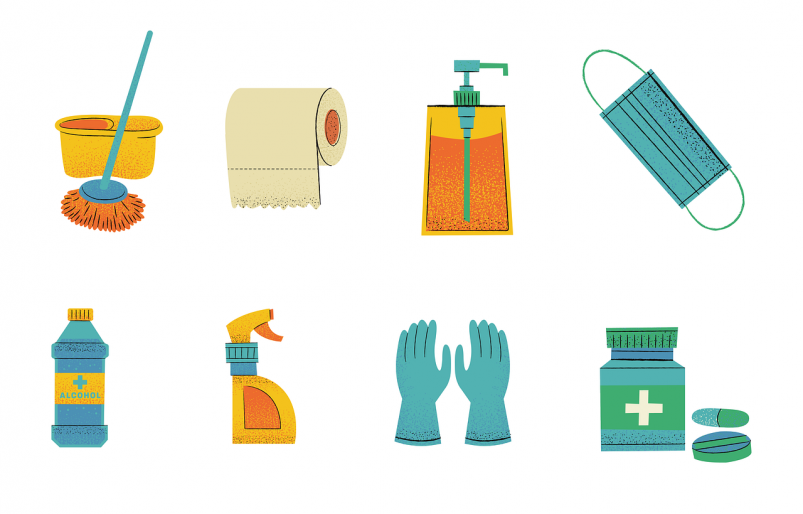Throughout the pandemic, facility managers and building service contractors have had to act quickly and prioritize cleaning measures to keep visitors and employees safe. A recent study found that 88 per cent of consumers pay close attention to the cleanliness levels of the businesses they frequent. Additionally, 86 per cent of consumers also value seeing proof that these places, including retail stores, restaurants, offices, gyms, or schools, are cleaned often.
In response, business leaders ramped up cleaning to give consumers and employees confidence while visiting their facilities. In fact, job openings for cleaning workers jumped 75 per cent from March 2019 to March 2020 due to the increased demand. To properly complete their work, these cleaning professionals need a range of cleaning supplies at their disposal. Knowing how to use them and when to refresh or replace them is equally essential.
Using and replacing cleaning tools correctly
Cleaning tools are responsible for the proper application of cleaning and disinfecting products. These may include mops and buckets, brushes and brooms, microfibre cloths, and more. Given the number of tasks that cleaning teams are now expected to complete daily, it can be easy to forget when these tools need to be replaced or upgraded. However, doing so on a regular basis is one of the keys to upholding the highest standards of cleanliness in commercial facilities.
There are a few telltale signs that a cleaning tool may no longer suit the requirements of cleaning staff. Consider the following “commandments of cleaning supplies” to ensure that employees have everything they need to successfully clean and disinfect.
- If it’s broken, fix it or replace it
The easiest way to determine if a cleaning tool needs to be replaced is to assess whether it can still be used in the way a manufacturer intends. For example, if the handle of a broom is cracking, a bucket has a leak or broken handle, or a microfibre cloth is fraying and has holes, you need to either fix the item or replace it. In some cases, repairs may make more sense financially. In other cases, purchasing a new tool is easier.
Broken tools can lead to injury, as they’re not able to be used correctly and employees may modify their movements or how they perform a certain task. In 2019, janitors and their employers reported over 18,600 workplace injuries, likely resulting from faulty equipment. Common injuries cleaning staff face include slips and falls, chemical exposure, skin allergies, and more. In order to keep these dedicated workers safe, regularly check inventory to make sure all items are in good working condition. Keeping replacements in stock and easily accessible by staff can help prevent potential injuries and the resulting time away from work.
- Avoid cross-contamination at all costs
When a staff member isn’t adequately trained on proper cleaning procedures, there can be serious, negative consequences, like cross-contamination. Cross-contamination, also called cross-infection, occurs when germs that cause diseases are transferred via unhygienic processes, thus leading to harmful health effects. A common example is when someone cleans the top of a toilet seat with a rag, then uses the same rag to wipe a sink or door handles.
To minimize the risk of cross-contamination, consider adding colour-coded rags, mop heads, and buckets to your team’s roster of cleaning supplies. Each area within a facility, like the kitchens, washrooms, and common areas, should be cleaned from top to bottom with a different-coloured set of cleaning tools to minimize cross-contamination. Additionally, once a towel has been used and folded over a few times for cleaning, it should be replaced with a fresh, clean cloth to reduce the spread of germs.
After each shift, ensure items are stored properly in a janitorial closet that has significant ventilation or airflow to help items dry well and avoid the growth of harmful bacteria. If tools need laundering, complete this process and be sure that clean mop heads and cloths are ready for the next shift.
- Switch to sustainable options
In some cases, your cleaning team may be equipped with tools that are working properly; however, now is the time to ask yourself if those tools are meeting your facility’s sustainability goals. Some of those goals could include producing less waste, increasing recycling metrics, achieving zero emissions by a certain date, and so on. If your current cleaning supplies aren’t meeting the goals you’ve outlined, consider upgrading to cleaning tools that are constructed in a more environmentally friendly way and help reduce water, chemical and energy consumption once implemented in your facility.
In 2019, nine in 10 consumers said they would hold an organization accountable for their environmental impact. Therefore, selecting a sustainable cleaning tool manufacturer with responsibly made solutions, like those that are Green Seal-certified, can improve brand reputation. Making a small change, such as switching to durable and sustainable cleaning tools, can have a positive, lasting impact on the environment as well.
Invest in your cleaning supplies
Overall, there are several examples of why a cleaning tool might need repair, replacement, refreshing or upgrading. Facility managers and building service contractors must remember that the tools that a cleaning team uses represent their facility or customer’s facility, and the brand as a whole. Therefore, it’s recommended that leaders keep a close eye on inventory and have open communication with staff to determine which improvements are needed and which upgrades best serve their needs. With the latest and most effective tools, you can improve your cleaning team’s experience and your commitment to cleanliness.
Carlos Albir Jr. Is Director of Operations at ABCO Cleaning Products, a leader in sustainable cleaning tools. ABCO is a family-owned, Certified Minority Business Enterprise with Green Seal certified products, headquartered in Miami, Fla.









